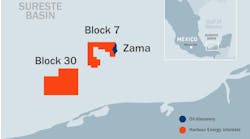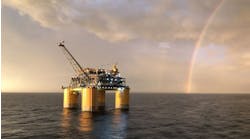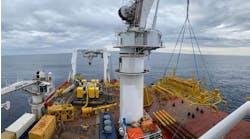Noble signs LOI for new semi
Noble Corp. indirect subsidiary Noble Drilling Services Inc. signed a letter of intent with a Marathon Oil Corp. subsidiary for theNoble Bingo 9000 Rig 4 semisubmersible hull for a two-year contract, with an option for an additional two years.
The semi, which will be renamed theNoble Jim Day, will be completed as a dynamically positioned (DPS-3) unit designed to operate in water depths to 3,658 m (12,000 ft) with accommodations for 200 people. The unit’s operational design will follow that of the Noble Danny Adkins, under construction in Singapore.
The semisubmersible is in the Jurong Shipyard in Singapore, where the company intends to complete the construction program. The rig is scheduled to be delivered in 4Q 2009.
Noble expects that Marathon will use theNoble Jim Day in the US Gulf of Mexico during its initial two years of service.
Discoveries
Helix Energy Solutions Group Inc. has hit pay in deepwater, while McMoran and Petsec Energy each reported drilling success in shallow water.
Helix completed drilling an exploration well and two appraisals on its 100%-owned Noonan prospect, confirming commercial pay.
Noonan is in Garden Banks block 506 in 823 m (2,700 ft) of water, about 233 km (145 mi) from Galveston, Texas.
According to Helix, “sufficient pay was encountered to point to reserve potential of at least 100 bcfe.”
Development plans being considered include a fast-track subsea tieback to existing infrastructure. First production is expected in the second half of 2008.
“We are obviously very pleased to have made a commercial discovery with the first prospect drilled from the deepwater inventory acquired as part of the Remington Oil and Gas transaction last year,” says Martin Ferron, Helix president and CEO.
“This demonstrates the considerable potential value of our deepwater resources, especially since we have over 20 high-quality prospects left to drill. The drilling of the deepwater prospect inventory, particularly with theQ4000, should create significant production returns and provide incremental contracting backlog to supplement an already buoyant medium-term deepwater service outlook.” The company plans to develop Noonan with its existing assets and services.
McMoran logged positive results while drilling the Hurricane Deep prospect on South Marsh Island block 217.
The well, drilled to 6,553 m (21,500 ft) TVD in 4 m (12 ft) of water, encountered 274 m (900 ft) of gross pay. The top of the reservoir’s Gyro sand has a potential 15 m (50 ft) net pay in a 16 m (53 ft) gross interval, according to McMoran.
The company says this points to commercial potential at its Gyro-trend Mound Point, JB Mountain, Hurricane, and Blueberry Hill prospects. All target Miocene sands.
According to the company, previous Hurricane Deep logs indicated 8 m (27 ft) of net pay over a 61-m (200-ft) gross interval in a Rob-L section of the reservoir, and potential 6 m (20 ft) of net pay over a 21 m (70 ft) gross interval in the Operc section. Pending final drilling results, the company plans to tieback the well to existing facilities.
Meanwhile, McMoran says its Blueberry Hill prospect in Louisiana State Lease 340 encountered four potentially hydrocarbon bearing sands below 6,767 m (22,200 ft).
Petsec Energy drilled a shallow gas discovery as well. The company hit pay with well No. 1 in Viosca Knoll bock 26, marking its fifth successive discovery in the Mobile Bay region.
According to Petsec, the discovery well, drilled to 1,402 m (4,627 ft) MD in 29 m (97 ft) of water, encountered 6.1 m (20 ft) of net gas pay. First production is expected in the third quarter.
At print, the company had spudded a second well from the same location targeting a zone in Mobile Bay block 994.
Deepwater transactions
Callon Petroleum Co. agreed to purchase BP’s 80% working interest in the Entrada field for $190 million in cash. The purchased interests include Garden Banks blocks 738, 782, 785, 826, and 827. Following completion of the acquisition, Callon will become operator and 100% owner of the field.
BP has assumed control of its new 11,334-sq-m (122,000-sq-ft) storage and preservation facility set on a 15-acre lot in Houma, Louisiana. BP plans to store materials here that it uses in deepwater drilling and completion, subsea, and production operations. Chouest designed and built the facility. Photo courtesy of Chouest.
The company estimates net proved reserves from the acquired assets are 13.7 MMbbl of oil and 68.1 bcf of natural gas. Associated net probable reserves are estimated at 13.7 MMbbl of oil and 32.9 bcf of natural gas. The acquisition is expected to close in the second quarter.
Meanwhile, Anadarko Petroleum Corp. agreed to sell a 23.2% working interest in the K2 field to two undisclosed parties for $1.2 billion. Following the transaction, Anadarko will remain operator of K2 with a 41.8% working interest. The transaction is expected to close in 2Q 2007 as well.
Fiber-optic load-out under way
BP began loading out its deepwater fiber-optic cable in March, according to Steve Fortune, BP’s Gulf of Mexico information management director. Fortune updated the status of the project while speaking on the benefits of using fiber optics with BP’s GoM deepwater facilities versus satellite communication at Microsoft’s Energy Forum in Houston.
“With massive amounts of data coming in from our deepwater production facilities through satellites, we found it created a bottleneck,” Fortune explained. BP’s 1,287-km (800-mi) fiber-optic loop initially will link seven of its deepwater hubs.
Fortune said the massive increase in bandwidth with fiber optics will help the company’s offshore teams access important documents and systems more efficiently. This also will improve the remote real-time monitoring of BP’s GoM deepwater facilities, and may eventually lead to complete remote operations, he added.
“The fiber-optic cable is being constructed in a way where it can be expanded to additional BP hubs as they come out in the GoM,” he said. The company also plans to eventually share it with other operators in the Gulf.
Offshore installation of the fiber-optic cable was scheduled to start in April, with a functional system expected by the end of September.
Hercules, TODCO to merge
Hercules Offshore Inc. entered into a definitive agreement to acquire 100% of the outstanding stock of TODCO in a stock and cash transaction valued at $2.3 billion, creating the world’s fourth largest jackup fleet, according to the companies.
The combined company will operate 33 jackup rigs, 27 barge rigs, 64 liftboats, three submersible rigs, nine land rigs, and one platform rig.
“This transaction positions Hercules Offshore as one of the leading shallow-water oil service providers globally,” says Randy Stilley, president, director and CEO of Hercules.
“Looking forward, Hercules Offshore will continue to focus on seeking strategic growth opportunities, expanding our geographic diversity and maintaining our status as a low-cost provider.”
“We believe the Hercules Offshore management team has proven acquisition and integration capabilities and will continue to capitalize on growth opportunities that exist in the fragmented offshore jackup drilling market,” says Jan Rask, president, director, and CEO of TODCO.
Closing of the transaction, subject to regulatory approvals and other customary conditions as well as both Hercules Offshore and TODCO shareholder approval, is expected mid-year.
MMS proposes rule change, publishes new recommendation
The MMS has proposed amendments to its regulations for oil and natural gas production on the OCS. The MMS says the proposed rule, Oil and Gas Production Requirements, 1010-AD12, would eliminate most restrictions on production rates and clarify flaring and venting limits.
According to the MMS, the rule would require operators to install meters to measure separately all flared and vented natural gas on facilities that process more than 2,000 b/d of oil.
The rule, the MMS adds, also would eliminate some previous production requirements. Those include the MMS’ requirement for operators to establish maximum production rates (MPRs) for producing well completions and maximum efficient rates (MERs) for producing reservoirs, in OCS Order No. 11. However, the MMS would retain the authority to set MPRs and MERs when necessary.
The rule also would clarify the approval process for operators for various operations.
The MMS is accepting comments on the proposed rule through June 4, 2007.
The regulatory agency also published a final rule to give operators options of best cementing practices to help mitigate shallow water flow (SWF) hazards in deepwater.
The rule, effective March 30, includes the First Edition of the American Petroleum Institute’s Recommended Practice for Cementing Shallow Water Flow Zones in Deepwater Wells (API RP 65).
According to the MMS, a SWF is the influx of water or sediment into or around a wellbore following the penetration of an abnormally pressured geologic formation.
From 1987 to 2004, at least 113 OCS wells encountered SWF, the MMS reports. The agency adds that while the majority of these wells experienced minor SWF, there have been severe cases resulting in abandonment and loss of wells.
Meanwhile, the MMS released findings from a year-long study of ocean currents in the northern GoM. The MMS says the information from this study can be used by engineers to design platforms and facilities to withstand strong deepwater currents.
According to the MMS, oceanographers conducted the study from March 2003 through April 2004 off the Mississippi Delta, where high-velocity currents are known to develop. The study confirmed that there are two layers of currents, according to Dr. Alexis Lugo-Fernandez, MMS physical oceanographer. The top layer is more powerful and stronger, he says, and near the bottom are small eddies, some 50-70 km (31-43 mi) in size.
Active hurricane season expected
Atlantic basin and US landfalling activity in 2007 is predicted to be about 75% higher than the 1950-2006 average, up from a 60% above norm forecast made in December 2006, according to London-based Tropical Storm Risk’s (TSR) March forecast. The company says this is the highest March prediction for activity since the consortium starting producing real-time forecasts in 1984.
TSR’s March forecast finds:
- An 86% probability of an above-average Atlantic hurricane season, an 11% probability of a near-normal season and a 3% chance of a below-normal season
- 17 tropical storms in the Atlantic basin, with nine developing into hurricanes and four strong hurricanes
- An 85% probability of above-average US landfalling hurricane activity, a 12% likelihood of a near-normal season and a 2% chance of a below-normal season
- Five tropical storms will hit the US; two will be hurricanes
- Two tropical storms will hit the Caribbean Lesser Antilles; one will be a hurricane.





